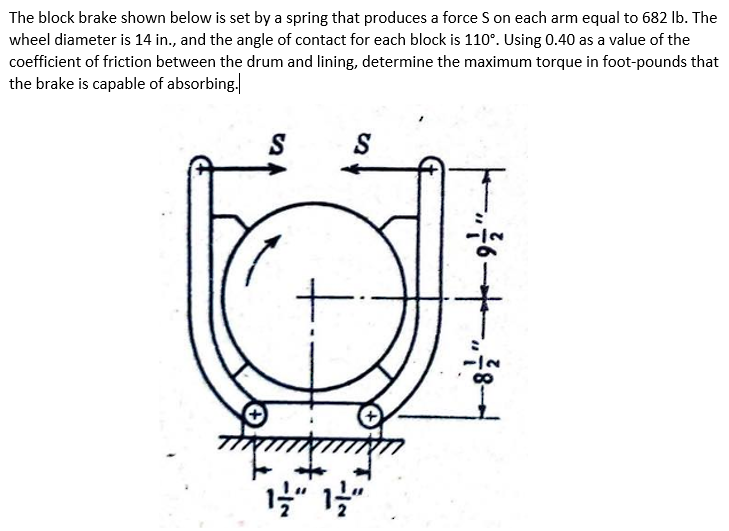The block brake shown below is set by a spring that produces a force S on each arm equal to 682 lb. The wheel diameter is 14 in., and the angle of contact for each block is 110°. Using 0.40 as a value of the coefficient of friction between the drum and lining, determine the maximum torque in foot-pounds that the brake is capable of absorbing. S + S 1/2" 1/2"
The block brake shown below is set by a spring that produces a force S on each arm equal to 682 lb. The wheel diameter is 14 in., and the angle of contact for each block is 110°. Using 0.40 as a value of the coefficient of friction between the drum and lining, determine the maximum torque in foot-pounds that the brake is capable of absorbing. S + S 1/2" 1/2"
International Edition---engineering Mechanics: Statics, 4th Edition
4th Edition
ISBN:9781305501607
Author:Andrew Pytel And Jaan Kiusalaas
Publisher:Andrew Pytel And Jaan Kiusalaas
Chapter7: Dry Friction
Section: Chapter Questions
Problem 7.55P: A wedge is used to prop up the 6000-lb block of marble. The wedge angle is =30, and the angle of...
Related questions
Question
100%

Transcribed Image Text:The block brake shown below is set by a spring that produces a force S on each arm equal to 682 lb. The
wheel diameter is 14 in., and the angle of contact for each block is 110°. Using 0.40 as a value of the
coefficient of friction between the drum and lining, determine the maximum torque in foot-pounds that
the brake is capable of absorbing.
S
+
S
1/2" 1/2"
Expert Solution
This question has been solved!
Explore an expertly crafted, step-by-step solution for a thorough understanding of key concepts.
Step by step
Solved in 2 steps with 2 images

Follow-up Questions
Read through expert solutions to related follow-up questions below.
Follow-up Question
can you please explain more and draw about summation of forces on this problem

Transcribed Image Text:= req
Considering
EM
↑
-
= S(a+b)
s(a+b)
s(a+b)
O
12
static equilibrium of the lever,
sx (a+b) + fxr
N =
S
=
s (a + b)
2 (1-Meg)
aximum torque, T = fr
Nr-fr.
Nr - Peq
Nr (1-Peq)
=
Nr
Nr
Peq
NXr
682 x (9½ +81
Solution
Knowledge Booster
Learn more about
Need a deep-dive on the concept behind this application? Look no further. Learn more about this topic, mechanical-engineering and related others by exploring similar questions and additional content below.Recommended textbooks for you

International Edition---engineering Mechanics: St…
Mechanical Engineering
ISBN:
9781305501607
Author:
Andrew Pytel And Jaan Kiusalaas
Publisher:
CENGAGE L

International Edition---engineering Mechanics: St…
Mechanical Engineering
ISBN:
9781305501607
Author:
Andrew Pytel And Jaan Kiusalaas
Publisher:
CENGAGE L